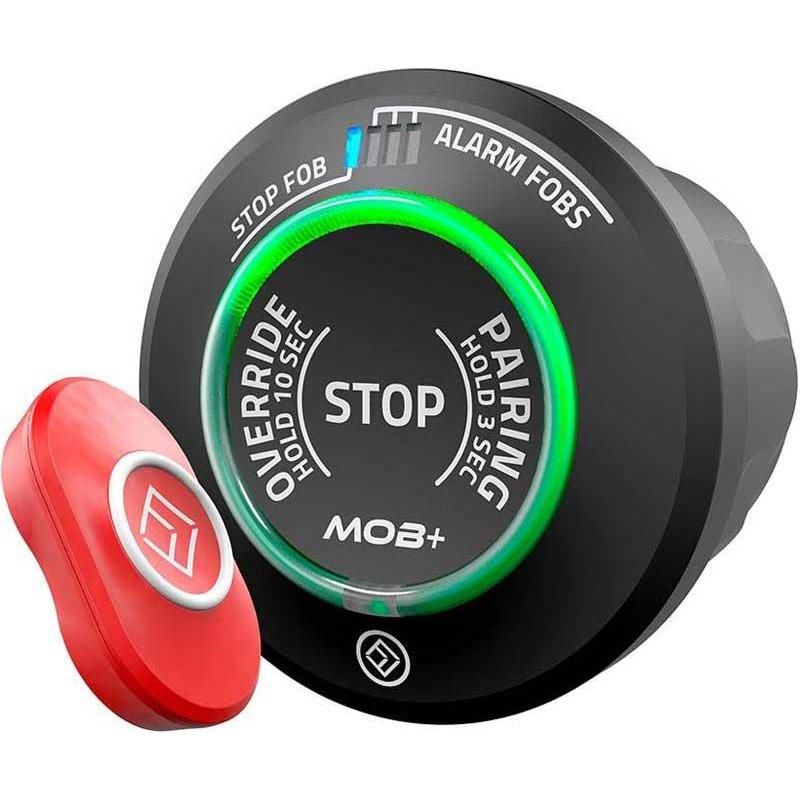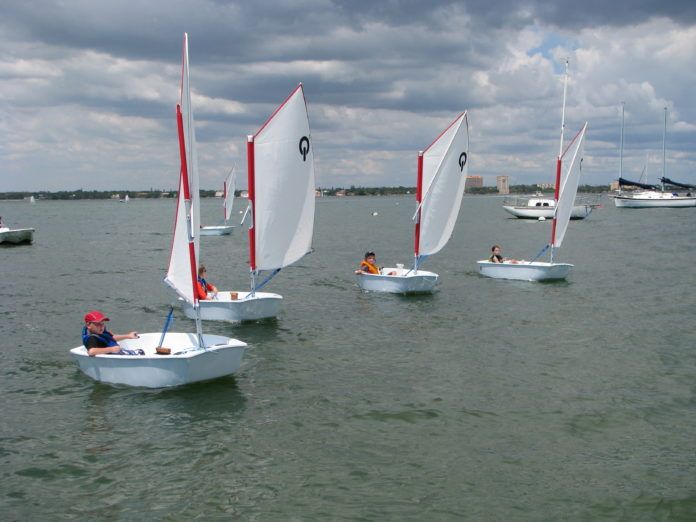In the wake of a terrible tragedy that struck a few days before Thanksgiving in Sarasota, Florida, home of the Sarasota Youth Sailing Program (as well as Practical Sailor’s editorial office), we’re asking all organized sailing programs to review their chase boat safety equipment and rescue protocols. Cruising sailors with planing dinghies should also take heed.
Specifically, owners of small planing boats should make sure the boat is outfitted with a fail-safe engine cut-off system. This can be a worn lanyard attached to a release clip that activates the motor’s kill switch (our preference), or possibly one of the devices reviewed in the November 2020 issue of Practical Sailor. If you do opt for one of the new wireless systems, these systems should be appropriate for this use, and tested frequently. Some of the new devices are aimed primarily at giving solo operators a chance at recovering their vessel after being ejected. These won’t be much help when operating in close quarters or other situations when near instantaneous cut-off is required.
The accident occurred during sailing practice for the SYSP Optimist fleet. The investigation is still ongoing, and not all the details have been released. Witnesses described the conditions as fun and challenging, but hardly unsafe, for the eight-foot boats. According to weather data, maximum winds were 14 knots on the day of the accident. The following statement from the Florida Fish and Wildlife Conservation Commission investigators describes what happened based on their initial findings.
“Based on preliminary information gathered from the scene and witnesses, it appears that the operator of a 20-foot vessel involved in the youth sailing practice was assisting the operator of an 8-foot sailboat who was experiencing issues with his vessel. While assisting the sailboat operator, the operator of the 20-foot vessel lost his footing and fell, resulting in the vessel being activated into gear and the operator being thrown from the vessel. The vessel continued, unmanned, and struck several 8-foot sailboats. Sadly, a third juvenile identified as Ethan Isaacs, age 10, passed away as a result of injuries sustained in this incident.”
Ethan attended the same school as my son. The sixth grader had recently won the county’s STEM competition, qualifying for districts. The grief that wracked the school and the local sailing community just days before Thanksgiving was gut wrenching. For Sarasota, a community with a rich history of sailing (the high school is home to the Sarasota Sailors), it is Ford Madox Ford’s “saddest story” times ten. Riley Baugh, the 18-year-old chase boat driver involved in the accident, has been active in the SYSP for several years. He has been described as an experienced boat operator, and according to the SYSP website, he was set to begin studies at the University of South Florida where he intended to participate on the sailing team.
Circle of Death
Sadly, this is not the first time a driverless small boat has had fatal consequences. Boating safety instructors have a name for the deadly course a powerboat follows once the driver is ejected. As we described in our report on electronic cutoff switches, “If your dinghy is fast enough to plane, it’s fast enough to buck you off the tubes. Most boats will immediately circle to the right as a result of prop torque, running you over repeatedly in what has been called the ‘circle of death.'”
The potential harm of a driverless boat is why engine makers have long had kill switches on all small outboard powered boats. Typically the switches are activated when a clip retaining a spring-loaded plunger switch is pulled free of its slot. The clip attaches to a lanyard that the driver wears. The driver goes over, the clip goes with them, and the motor shuts off. The problem is that many people–fisherman especially–don’t use these lanyards because they interfere with other onboard activities. While wearing the lanyard, the operator can’t leave the engine running while they adjust a trolling line, check their live bait well, get a drink from the cooler . . . or pull someone from the water. Thus, the rising popularity of the wireless electronic cut-off switch.

Activated by proximity (killing the engine as the driver moves a fixed distance away from the helm) or upon immersion, wireless kill switches would seem to be a promising solution to some of the risks posed by a driverless boat, but not all designs are applicable to certain situations. Our test focused on the pros and cons of the competing designs, but it did not look at long-term operation, maintenance regimens, or operation under more challenging conditions (rain, cold, extreme heat, etc.). The new switches will soon become ubiquitous as a result of new guidelines in the Code of Federal Regulations as a result of the Frank LoBiondo Coast Guard Authorization Act of 2018, which requires that all recreational boats less than 26 feet, and capable of producing more than 115 pounds of thrust, be equipped with an engine cut-off device. According to federal code, compliant devices must meet the American Boat and Yacht Council’s A-33, Emergency Engine/Propulsion Cut-off Devices (2018).
Established in 1954, the ABYC describes itself as “a non-profit industry group that develops voluntary global safety standards for the design, construction, maintenance, and repair of recreational boats.” It is one of several groups around the world that publishes standards to help smooth the regulatory and trade waters for marine manufacturers, who pay a fee to gain access to ABYC’s published standards. As technology has evolved and global markets have opened, the challenges navigating these consumer safety regulations have multiplied, making industry groups like the ABYC essential to any business plan.
Boating Safety Conundrum
For avid sailors, especially those who compete, complying with all the safety regulations established by the government or by the sport’s governing body (World Sailing, and US Sailing in the U.S.) can get expensive. Boating is inherently risky, so the sky is the limit on devices that can be introduced to make it safer. Once these devices become required, innovators are ensured a steady stream of boating customers, who now must carry more gear to avoid paying fines. As a result, there is often a push from innovators to have their new safety product legislated into use, and, regardless of the efficacy of the product, boaters often resist the new rules.
For the average sailor, the current lanyard release clips—which are practically foolproof when used properly—are perfectly suitable for dinghy engines. These devices were used in the engines we reviewed during our 2016 outboard test, and they all operated flawlessly. Outboard powered sailboats, on the other hand, would benefit from a wireless cutoff switch that lets the operator set the main, trim sheets, or take bearings while under autopilot.

But the wireless systems are also more complex. As anyone who owns a boat knows, the more complex the system, the more prone it can be to failure. Often that failure is not the fault of the equipment itself, but is due to the user’s failure to understand its limitations. As we pointed out in our report, the new electronic cutoff devices have some obvious limitations. To rely on a safety device without knowing its limits can actually add risk in some situations.
The classic example of the consumer safety conundrum is the auto-inflating Type V PFD, which after years of lobbying from manufacturers was finally approved for use in the 1980s. Inflatable PFDs have undoubtedly saved countless lives, simply by virtue of the fact that they work most of the time and boaters actually wear them. However, the record of their failure (often due to lack of maintenance by the owner) and vulnerabilities in certain scenarios are well documented (see PS July 2019, “Reframing Our Views on the Automatic Inflating PFD“). But just because something can fail, doesn’t mean it’s a bad idea. Inflatable PFDs save lives. Period. No doubt wireless switches, when used as intended, will do the same.
We don’t yet know if the boat involved in the Sarasota accident was protected by an emergency cutoff device, or whether a lanyard clip or one of the electronic devices that we recently reviewed would have prevented the tragedy. Perhaps better non-skid coating, or no-slip shoes would have been a more effective measure.
Some of the cutoff devices we looked at won’t stop the outboard until it is at least 50 feet away from the operator, and probably would not have been much help. What is clear is that all operators of small outboard boats need to be fully aware of the risks of accidentally engaging the throttle, and do their best to prevent this from happening. With the growing popularity of electronic “fly by wire” throttles that engage with very little pressure, the need for care and vigilance is even greater than before.
In general, whenever there are people in the water near your powerboat or dinghy, just shutting off the engine is the best precaution. Fortunately, shutting down the engine is something that should come naturally to a sailor.








































During my US Sailing Level 1 certification, we were told to turn motors off during assistance or rescue procedures. Also, some feel that a “safety” boat should have two people on board. During a rescue, one person has his hands full.
Bill Records
Austin Yacht Club
In my experience, which comprises of more than 70 years of sailing and operating outboards, two people are essential to be safely helpful in a rescue or safety boat. Furthermore a lanyard cut off can be dangerous in certain circumstances such as traversing a rough inlet sea.
There was a long discussion thread on a Tanzer group I belong to on the need for a safety device for autopilots. The concesus was a device that would put the helm hard over if activated. If under power, shutting down the engine would also be necessary. But if you’re single handing and go overboard under sail with a pilot engaged, wearing your PFD, you’ll watch your boat sail away over the horizon.
One option is to attach the lanyard to your ankle…does still restrict your movements of course, but can give you a bit more reach.
C’est genial, mais porquoi est que vous etes heureuse? L’histoire se semble triste.
Sympathies to all parents and relatives. The advice regarding kill cord applies to any outboard dinghy. My RYA safety boat instructor would consider I failed if it wasn’t used.
It’s possible to drive (safely!) within a few feet of a planing dinghy provided the power boat driver can anticipate the actions of the perched.
I’ve always found that I need to cut the engine to talk with a right helm (ok – shout first, the cut engine to coach a student). If nothing else, teaches the student how to heave-to alongside a motor boat.
Colin
So very tragic, sad and life changing to all those involved. The one option not discussed is the cage over the prop on chase boats. These boats have low performance needs and should be expected to be involved with people in the water.
This sounds like such a dangerous situation it might have happened with a protected prop but in general, agreed Kip. This lesson has already been learned the hard way and some states have mandated the cages, they actually have almost no effect on performance, no club should have coach boats without them. And truly young coaches need to be 2 in a boat.